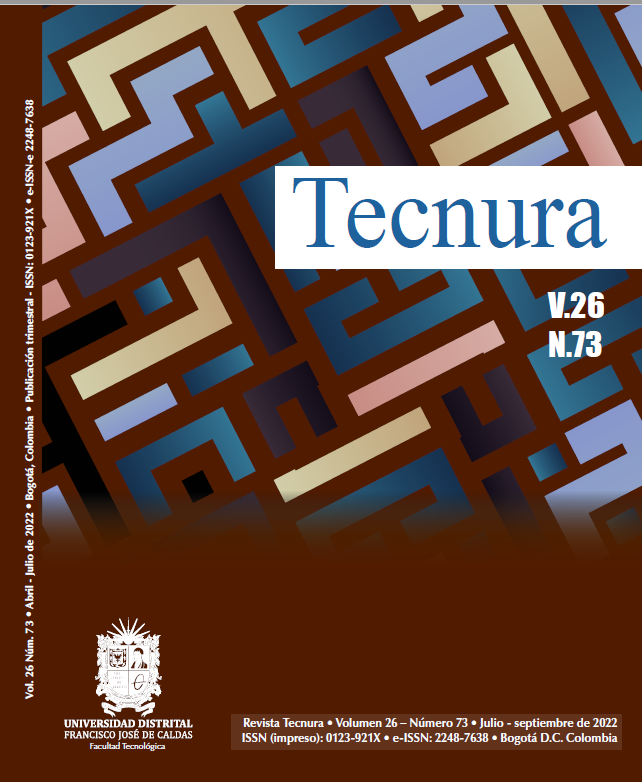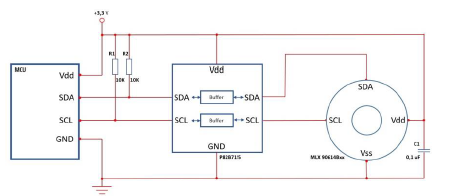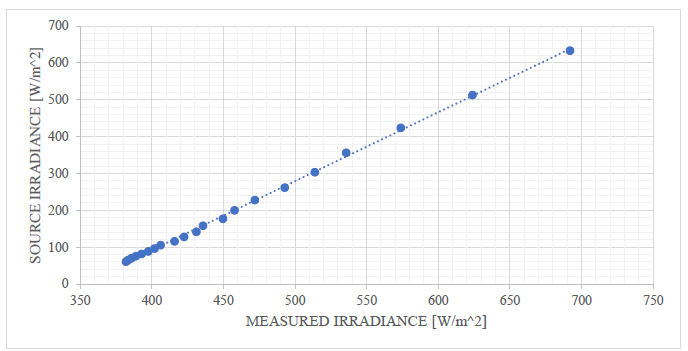DOI:
https://doi.org/10.14483/22487638.19157Publicado:
01-07-2022Número:
Vol. 26 Núm. 73 (2022): Julio - SeptiembreSección:
InvestigaciónLow-cost Prototype Pyrgeometer for Atmospheric Radiation Measurements
Prototipo de pirgeómetro de bajo costo para mediciones de radiación atmosférica
Palabras clave:
emissivity, black body, thermal radiation, irradiance, pyrgeometer (en).Palabras clave:
emisividad, cuerpo negro, radiación térmica, irradiancia, pirgeómetro (es).Descargas
Referencias
Carbone Stainless Steel (n.d.). Ficha técnica del acero inoxidable.
https://www.empresascarbone.com/pdf/ficha-tecnica-del-acero-inoxidable.pdf
Desai, P. D., Chu, T. K., James, H. M., & Ho, C. Y. (1984). Electrical resistivity of selected elements. Journal of Physical and Chemical Reference Data, 13(4), 1069-1096. https://doi.org/10.1063/1.555723 DOI: https://doi.org/10.1063/1.555723
Enz, J. W., Klink, J. C., & Baker, D. G. (1975). Solar radiation effects on pyrgeometer performance. Journal of Applied Meteorology, 14(7), 1297-1302. https://doi.org/10.1175/1520-0450(1975)014<1297:SREOPP>2.0.CO;2 DOI: https://doi.org/10.1175/1520-0450(1975)014<1297:SREOPP>2.0.CO;2
Fairall, C. W., Persson, P. O. G., Bradley, E. F., Payne, R. E., & Anderson, S. P. (1998). A new look at calibration and use of Eppley precision infrared radiometers. Part I: Theory and application. Journal of Atmospheric and Oceanic Technology, 15(6), 1229-1242. https://doi.org/10.1175/1520-0426(1998)015%3C1229:ANLACA%3E2.0.CO;2 DOI: https://doi.org/10.1175/1520-0426(1998)015<1229:ANLACA>2.0.CO;2
Gloyne, R. W., & Lomas, J. (1980). Lecture notes for training class II and class III agricultural meteorological personnel. Secretariat of the World Meteorological Organization. https://library.wmo.int/doc_num.php?explnum_id=1046
Hu, F., & Lucyszyn, S. (2015). Modelling Miniature incandescent light bulbs for thermal infrared ‘THz Torch’ applications. Journal of Infrared, Millimeter, and Terahertz Waves, 36(4), 350-367. https://doi.org/10.1007/s10762-014-0130-8 DOI: https://doi.org/10.1007/s10762-014-0130-8
Kano, M., & Suzuki, M. (1976). On the calibration of the radiometer for longwave radiation. II - The case of pyrgeometer. Papers Meteorology Geophysics, 27, 33-39. https://doi.org/10.2467/mripapers1950.27.1_33 DOI: https://doi.org/10.2467/mripapers1950.27.1_33
Manrique-Valadez, J. A. (2002). Transferencia de calor (2nd ed.). Oxford University Press.
Marín-Naranjo, L. D. (2011). Análisis de la ley de cuadrado inverso para medición práctica de iluminancia. Revista Ingeniería, 19(1), 687. https://doi.org/10.15517/ring.v19i1.687 DOI: https://doi.org/10.15517/ring.v19i1.687
Melexis (n.d). MLX90614 datasheet. https://www.melexis.com/en/documents/documentation/datasheets/datasheet-mlx90614
Polo, J. (2010). Optimización de modelos de estimación de la radiación solar a partir de imágenes de satélite (Tesis Doctoral). Universidad Coplutense de Madrid, Madrid, España.
Stoffel, T., Reda, I., Hickey, J., Dutton, E., & Michalsky, J. (2006). Pyrgeometer calibrations for the atmospheric radiation measurement program: Updated approach. https://www.arm.gov/publications/proceedings/conf16/extended_abs/stoffel_t.pdf
Valea-Pérez, Á., & Alonso-Girón, J. M. (1998). Radiación Infrarroja y Ultravioleta. Tecnología y aplicaciones. McGraw-Hill.
Cómo citar
APA
ACM
ACS
ABNT
Chicago
Harvard
IEEE
MLA
Turabian
Vancouver
Descargar cita
Recibido: 23 de octubre de 2021; Aceptado: 20 de abril de 2022
ABSTRACT
Objective:
To design and build an instrument capable of measuring long-wave infrared radiation with elements of the national market that offers an excellent performance in measuring energy in this spectral band.
Methodology:
The best design was determined based on other existing instruments, innovating its development by using materials that are easily accessible in the country, and its operation was verified by characterizing an incandescent light bulb used as an infrared radiation pattern. Then, the radiation measured by the instrument was compared to that emitted by the source by means of an experimental setup that involved measuring the temperature at several distances.
Results:
A functional prototype was obtained, and its operation could be verified through a series of irradiance measurements according to the Stefan-Boltzmann law, through a calibration process with a known radiation source.
Conclusions:
A radiometric instrument for the thermal infrared band was designed and built. Raw materials and electronic components were used which were available in the local market, thus noticeably reducing the equipment’s production costs.
Funding:
This research was funded by the authors.
Keywords:
emissivity, black body, thermal radiation, irradiance, pyrgeometer.RESUMEN
Objetivo:
Diseñar y construir un instrumento capaz de medir la radiación infrarroja de onda larga con elementos del mercado nacional que ofrezca un excelente desempeño en la cuantificación de energía en esta banda espectral.
Metodología:
Se determinó el mejor diseño, basado en otros instrumentos ya existentes, innovando su desarrollo mediante el uso de materiales de fácil acceso en el país, y se comprobó su funcionamiento mediante la caracterización de una bombilla incandescente usada como patrón de radiación infrarroja. Luego se comparó la radiación medida por el instrumento con la radiación emitida por la fuente mediante un montaje experimental en el que se midió la temperatura a diversas distancias.
Resultados:
Se obtuvo un prototipo funcional, siendo posible constatar su funcionamiento mediante una serie de medidas de irradiancia en consonancia con la ley de Stefan-Boltzmann, a través de un proceso de calibración con una fuente de radiación conocida.
Conclusiones:
Se diseñó y construyó un instrumento radiométrico para la banda espectral del infrarrojo térmico. Se emplearon materias primas y componentes electrónicos disponibles en el medio local, reduciendo notablemente los costos de producción del equipo.
Financiamiento:
Esta investigación fue financiada por los autores.
Palabras clave:
emisividad, cuerpo negro, radiación térmica, irradiancia, pirgeómetro.INTRODUCTION
Currently, meteorology, particularly agricultural meteorology, utilizes very well-developed equipment. This includes the pyrgeometer, an instrument for measuring long-wave infrared radiation, whose acquisition costs are excessive, which limits energy quantification and research on radiation-atmosphere interaction, since, in order to analyze this phenomenon, it is necessary to perform precise and quantified measurements (Stoffel et al., 2006).
Infrared radiation (IR), is one of the several types of radiation that conform the electromagnetic spectrum, in addition to visible and ultraviolet radiation, gamma rays, etc. The infrared band covers all wavelengths between 740 nm and 1 mm. It is possible to subdivide the IR strip into three regions based on its wavelength, as shown in Table 1.
Table 1: Spectral domain of infrared radiation
Type IR
Radiation
Wavelenght - λ(μm)
Short wave
IR-A
0,76 - 2
Medium wave
IR-B
2 - 4
Long wave
IR-C
4 - 1000
Therefore, an instrument capable of measuring long wave radiation with components that are easily accessible in the local market was designed and built in this study, as a contribution for creating agricultural alert networks and performing energy balances and climate control in greenhouses (Gloyne & Lomas, 1980; Fairall et al., 1998), thus generating greater yields in harvests and allowing to establish meteorological stations or complement existing ones.
THEORETICAL FOUNDATIONS
A black body is one that has the ability to absorb all of the radiation it receives. it also emits radiation at any temperature greater than 0 K at various wavelengths. This is possible because none of the absorbed radiation is reflected or transmitted. Hence the name, because it is due to this phenomenon that the human eye perceives these bodies to be of a deep black color (Manrique-Valadez, 2002).
Because the sun behaves as a black body with a 6.000 K surface temperature and is the main source of energy on Earth, it has become necessary to develop instruments capable of quantifying this energy in the different bands of the electromagnetic spectrum. A pyrgeometer is one of such instruments, basically composed of an appropriate housing for outdoor exposure, a transducer element responsible for the detection of thermal infrared radiation (both from the sun and the atmosphere), and a dome that is in charge of filtering components of the electromagnetic spectrum which are outside the long-wave IR.
Stefan-Boltzmann law
The Stefan-Boltzmann law establishes a relationship between the power per unit area radiated by a black body and its surface temperature. This relationship is expressed by Equation (1).

where σ is the Stefan-Boltzmann constant and has a value of
 (International Unit System). This shows a large increase in the power per unit area radiated by a body in relation to its temperature (Valea-Pérez & Alonso-Girón, 1998). Equation (2) is used for a real surface (not a black body),
(International Unit System). This shows a large increase in the power per unit area radiated by a body in relation to its temperature (Valea-Pérez & Alonso-Girón, 1998). Equation (2) is used for a real surface (not a black body),

where the emissivity coefficient is represented by ε, referring to the ability to emit radiation within a range between 0 and 1, which depends on the wavelength at which said body emits, as well as on the surface temperature (Valea-Pérez & Alonso-Girón, 1998). Due to the properties of space, there is a relationship between the power radiated by a source and the distance of the object that receives it. This relationship is established through Equation (3) (Marín-Naranjo, 2011):

where I is the irradiance of the source, P is the total radiation power emitted by the source, and r is the separation distance between the source and the receiver.
METHODOLOGY
Instrument design
The housing was made of 304 stainless steel, a material selected due to its low thermal conductivity coefficient compared to other metals, which minimizes errors caused by internal heating in the measurements of the instrument (Carbone Stainless Steel, n.d.). The housing is composed of two parts: the first one is a base with a porthole level and its corresponding screws, with the purpose of adjusting the degrees of inclination of the sensor; and the second one is the body, a hollow structure in which the circuit is located, as well as a 4-pin mini-din port for feeding and extracting information from the instrument, a Fresnel lens (a component responsible for filtering the radiation that reaches the transducer) and, inside it, silica gel, whose objective is to eliminate excess humidity. Figure 1 shows the technical specifications of the constructed housing.
Figure 1: Plans: above, base of the instrument; down, body of the instrument
The printed circuit consists of the transducer, a contactless temperature sensor manufactured by the MELEXIS company (MLX90614B), which detects the temperature by means of a thermopile. It is equipped with an optical filter which rejects radiation outside a range between 5,5 and 14 µm. The sensor output is based on an 𝐼2𝐶 communication protocol and has a resolution of 0,02 °C. (Melexis, n.d.). A necessary buffer was implemented to allow transmitting the characteristic signals of the 𝐼2𝐶 through a shielded cable. Passive components such as a 10 KΩ resistor pair and a 0,1 µF capacitor were also included. Figure 2 is a representation of the circuit connections.
Figure 2: Connection scheme of the electronic circuit
Characterization of the bulb
The first task involved determining a known radiation source. A 250 W incandescent bulb was used, which had to be characterized in order to quantify the amount of energy radiated by its tungsten filament. This bulb was disassembled to measure its dimensions, with the purpose of calculating its resistivity by means of the formula
 , where the resistance R is obtained from the voltage and current values measured on the bulb. Based on the data published in the article by Desai et al. (1984), the function 𝜌=𝑎𝑇2+𝑏𝑇+𝑐 was obtained using a least squares approximation, where the resistivity depends on the temperature. This yields the solution of quadratic Equation (4), where the temperature is a function of resistivity.
, where the resistance R is obtained from the voltage and current values measured on the bulb. Based on the data published in the article by Desai et al. (1984), the function 𝜌=𝑎𝑇2+𝑏𝑇+𝑐 was obtained using a least squares approximation, where the resistivity depends on the temperature. This yields the solution of quadratic Equation (4), where the temperature is a function of resistivity.

with:

After obtaining the emitted temperature, the emissivity of the bulb was determined via Equation (5) (Hu & Lucyszyn, 2015), which is essential to finding its irradiance with Equation (2) and comparing it with the irradiance captured by the constructed instrument.

To calibrate the instrument, a method involving the characterization of a known radiation source was used. In order to observe the behavior of the instrument according to the inverse-square law, the instrument was installed in an optimal position to capture the radiation generated by the known source. In addition, a mechanism was built with two wooden supports in order to vary the distance between the radiation source and the sensor, always with stable potential and current differences in the bulb. The experiments were performed inside a room with a heating system that allowed taking measurements within a range of atmospheric temperatures.
RESULTS
Characterization of the bulb
Table 2 shows the data obtained according to the voltage variation in the bulb regarding its characterization, which includes the calculations of resistivity, temperature, and emissivity for the radiation source.
Source: Authors
Table 2: Data for the characterization of the bulb
V [V]
I[A]
R[Ω]
ΔR[Ω]
ρ[Ωm]
Δρ[Ωm]
T[K]
ΔT[K]
ε
I [W/m^2]
16,88
0,95
177,684
9,357E-02
2,509E-07
2,076E-08
1,003E+03
88,683
1,144E-01
6,558E+03
24,35
1,08
225,463
1,044E-01
3,184E-07
2,613E-08
1,231E+03
106,157
1,451E-01
1,890E+04
31,55
1,19
265,126
1,114E-01
3,744E-07
3,057E-08
1,414E+03
119,736
1,697E-01
3,841E+04
40,00
1,32
303,030
1,148E-01
4,279E-07
3,476E-08
1,583E+03
131,959
1,924E-01
6,843E+04
47,60
1,43
332,867
1,164E-01
4,700E-07
3,805E-08
1,712E+03
141,167
2,098E-01
1,023E+05
54,70
1,53
357,516
1,169E-01
5,048E-07
4,075E-08
1,817E+03
148,515
2,239E-01
1,385E+05
62,22
1,63
381,718
1,171E-01
5,390E-07
4,340E-08
1,919E+03
155,542
2,375E-01
1,825E+05
69,30
1,72
402,907
1,172E-01
5,689E-07
4,572E-08
2,006E+03
161,5512
2,492E-01
2,288E+05
75,60
1,79
422,346
1,180E-01
5,964E-07
4,786E-08
2,085E+03
166,991
2,598E-01
2,785E+05
85,30
1,91
446,597
1,169E-01
6,306E-07
5,050E-08
2,182E+03
173,556
2,729E-01
3,510E+05
93,70
2,00
468,500
1,172E-01
6,615E-07
5,289E-08
2,269E+03
179,412
2,845E-01
4,276E+05
100,70
2,07
486,473
1,175E-01
6,869E-07
5,487E-08
2,339E+03
184,143
2,940E-01
4,991E+05
105,00
2,12
495,283
1,168E-01
6,994E-07
5,582E-08
2,373E+03
186,402
2,986E-01
5,371E+05
108,80
2,12
513,208
1,211E-01
7,247E-07
5,784E-08
2,442E+03
191,163
3,078E-01
6,209E+05
112,50
2,15
523,256
1,217E-01
7,389E-07
5,895E-08
2,481E+03
193,736
3,130E-01
6,719E+05
Measurements with the instrument at different distances
The data taken by the sensor were recorded during the test performed with the known radiation source at a constant power of 2,5794 ×102 W, which was determined from the formula 𝑃=𝐴𝑠𝜀𝜎??4, varying the separation distances between the source and sensor. In the formula, P is the power radiated by the source, A s is the superficial area of the tungsten filament, ε is the emissivity of the filament, σ is the Stefan-Boltzmann constant, and T is the temperature of the filament.
In Figure 3, it is possible to identify the behavior of the sensor with respect to the radiation values emitted by the source at different distances. From the graph, a non-linear behavior is evidenced, resulting in the trend curve described by Equation (6), with a correlation coefficient 𝑅2=0,990691767716456. This equation was used to adjust the data according to their corresponding error percentage.

Figure 3: Expected vs. measured values (-0,97 - 59,39 °C)
A second approximation was made which consisted of separating the behavior into two regions, with the purpose of minimizing uncertainty.
Figure 4 shows the trend curve described by Equation (7), with a correlation coefficient 𝑅2=0,990066461453337.

Figure 4: Expected vs. measured values (-0,97 - 13,01 °C)
In the second region, the best approximation is linear (Figure 5).
Figure 5: Expected vs. measured values (13,49 - 59,39 °C)
The trend curve described by Equation (8) has a correlation coefficient 𝑅2=0,999046006003953.

In Equations (7) and (8), the data were adjusted with their corresponding error percentage. Figure 6 shows the linear relationship between the measured irradiance and the inverse of the squared distance with respect to the emitting source. This, in a range of -0,97 - 59,39 °C.
Figure 6: Radiometer behavior with regard to its distance to the source
CONCLUSIONS
The elaborated instrument shows an excellent performance in the measurement of atmospheric radiation because it has a good response in a range of atmospheric temperatures (-0,97 - 59,39 °C) at a considerably low cost (US$ 3.000) compared to similar instruments found in the international market.
The FRESNEL lens fulfills a fundamental task in the capture and filtration of infrared radiation, thus allowing the transducer to measure correctly by concentrating the infrared thermal radiation towards it.
The characterization of the bulb served as a method to evaluate a known radiation source, through which the sensor could be reliably calibrated.
The instrument was developed with elements that are easily accessible in the national market, thus significantly reducing its production costs. The instrument can be used in the area of solar radiometry, in agricultural productivity measurements, and in instrumentation studies in the field of meteorology.
In the future, it is necessary to compare this instrument with standard equipment, given that the standard pyrgeometer of the Colombian Institute for Hydrology, Meteorology, and Environmental Studies (IDEAM) was not available for measurements.
REFERENCES
Licencia
Esta licencia permite a otros remezclar, adaptar y desarrollar su trabajo incluso con fines comerciales, siempre que le den crédito y concedan licencias para sus nuevas creaciones bajo los mismos términos. Esta licencia a menudo se compara con las licencias de software libre y de código abierto “copyleft”. Todos los trabajos nuevos basados en el tuyo tendrán la misma licencia, por lo que cualquier derivado también permitirá el uso comercial. Esta es la licencia utilizada por Wikipedia y se recomienda para materiales que se beneficiarían al incorporar contenido de Wikipedia y proyectos con licencias similares.








